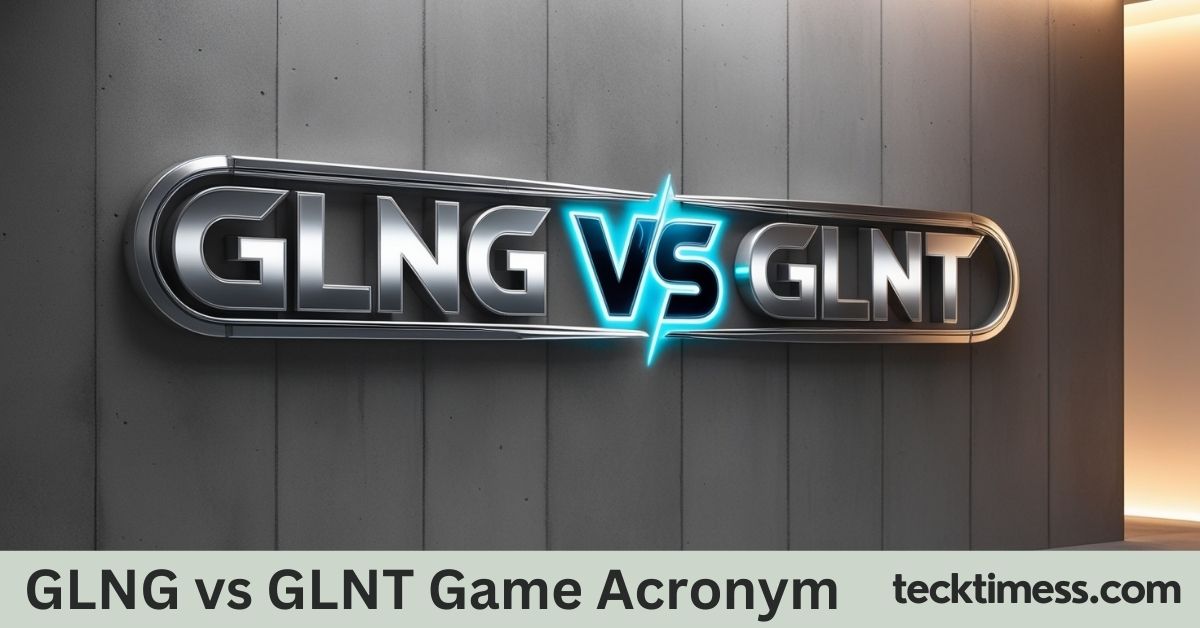In the ever-evolving world of video games and esports, acronyms play a crucial role in shaping communication and culture. Two acronyms that have gained significant attention in recent years are GLNG and GLNT. While they may look similar at first glance, these acronyms represent distinct concepts that are reshaping the gaming landscape in unique ways. This article will dive deep into the meanings, origins, and implications of GLNG vs GLNT game acronyms, exploring how they impact players, communities, and the broader gaming industry.
What is GLNG?
GLNG stands for “Good Luck, No Grief.” This acronym emerged as a response to toxic behavior in online gaming communities. The phrase encourages players to wish their opponents good luck while refraining from disruptive or negative actions during gameplay.
Origins of GLNG
The GLNG movement began in the early 2010s as gamers sought ways to combat the rising tide of toxicity in online multiplayer games. Frustrated by constant trash talk, griefing, and unsportsmanlike conduct, a group of players started using “GLNG” in pre-game chat to set a positive tone for matches.
Key Principles of GLNG:
- Sportsmanship: Wishing opponents good luck before a match
- Respect: Avoiding insults, taunts, or disruptive behavior
- Positive attitude: Focusing on fun and fair play rather than just winning
- Community building: Encouraging a welcoming environment for all players
Impact of GLNG on Gaming Culture
The GLNG movement has had a noticeable impact on many gaming communities:
- Reduced toxicity: Some games report lower instances of reported negative behavior
- Improved player retention: New players feel more welcome and are likely to continue playing
- Enhanced competitive integrity: Matches focus more on skill than psychological warfare
- Positive brand associations: Games embracing GLNG principles often receive praise from critics and players alike
What is GLNT?
GLNT stands for “Gaming League of New Talent.” Unlike GLNG, which focuses on player behavior, GLNT is an organization dedicated to discovering and nurturing emerging gaming talent.
Origins of GLNT
The Gaming League of New Talent was founded in 2018 by a group of esports veterans and talent scouts. They recognized the need for a structured system to identify promising young players and help them transition into professional gaming careers.
Key Focus Areas of GLNT:
- Talent scouting: Identifying skilled players through online tournaments and regional events
- Skill development: Providing coaching and training programs to refine raw talent
- Industry connections: Introducing promising players to professional teams and sponsors
- Education: Offering guidance on the business side of esports and streaming
- Community support: Creating a network of like-minded aspiring pros
Impact of GLNT on the Gaming Industry
Since its inception, GLNT has made significant contributions to the esports ecosystem:
- New star players: Several top-tier professionals got their start through GLNT programs
- Increased diversity: GLNT actively seeks out talent from underrepresented communities
- Improved infrastructure: The organization has helped standardize talent development pipelines
- Economic opportunities: GLNT graduates often secure lucrative contracts and sponsorships
- Legitimacy: The existence of GLNT has helped further legitimize gaming as a viable career path
Comparing GLNG and GLNT: Key Differences
While both acronyms are important in the gaming world, they serve very different purposes:
- Focus
- GLNG: Emphasizes player behavior and community culture
- GLNT: Concentrates on talent development and professional opportunities
- Scope
- GLNG: Applies to all players, from casual to professional
- GLNT: Primarily targets highly skilled players with professional aspirations
- Implementation
- GLNG: Grassroots movement adopted by individual players and communities
- GLNT: Formal organization with structured programs and events
- Primary Goals
- GLNG: Improve the overall gaming experience for everyone
- GLNT: Create the next generation of esports stars and content creators
- Timeframe
- GLNG: Immediate impact on individual games and interactions
- GLNT: Long-term focus on career development and industry growth
How GLNG and GLNT Complement Each Other
Despite their differences, GLNG and GLNT can work together to create a more positive and professional gaming ecosystem:
- Positive role models: GLNT-trained players can champion GLNG principles, setting an example for aspiring pros
- Improved competition: GLNG creates a better environment for GLNT talent to showcase their skills
- Community growth: Both initiatives attract new players to games, expanding the talent pool
- Industry standards: Together, they help establish best practices for behavior and talent development
- Brand partnerships: Companies are more likely to invest in gaming when toxicity is low and new talent is plentiful
Implementing GLNG in Your Gaming Experience
If you’re inspired by the GLNG movement, here are some ways to incorporate its principles into your gameplay:
- Use the acronym: Type “GLNG” in pre-game chat to set a positive tone
- Lead by example: Refrain from trash talk and focus on your own performance
- Encourage teammates: Offer support and constructive feedback instead of criticism
- Report negative behavior: Use in-game tools to report players who violate GLNG principles
- Spread the word: Share the concept with friends and online communities
Getting Involved with GLNT
For players interested in pursuing a professional gaming career, GLNT offers several entry points:
- Online tournaments: Participate in GLNT-sponsored events to get noticed
- Regional qualifiers: Attend local events to compete against other aspiring pros
- Coaching programs: Sign up for GLNT training sessions to improve your skills
- Mentorship opportunities: Connect with experienced players through GLNT networks
- Content creation: Showcase your personality through GLNT streaming initiatives
The Future of GLNG and GLNT in Gaming
As the gaming industry continues to grow and evolve, both GLNG and GLNT are likely to play increasingly important roles:
GLNG:
- Integration into game design: Developers may incorporate GLNG principles into reward systems
- Esports regulations: Major tournaments could require players to adhere to GLNG standards
- AI moderation: Advanced systems might use GLNG guidelines to automatically detect toxic behavior
- Educational initiatives: Schools and parents may embrace GLNG to teach digital citizenship
GLNT:
- Global expansion: The organization could establish branches in emerging gaming markets
- Cross-game expertise: GLNT might develop programs for players to excel in multiple titles
- Virtual reality training: As VR gaming grows, GLNT could pioneer new training techniques
- Industry partnerships: More game publishers may work directly with GLNT to nurture talent
Challenges and Controversies
While both GLNG and GLNT have garnered significant support, they also face some challenges:
GLNG:
- Resistance from some players who view trash talk as part of gaming culture
- Difficulty in enforcing principles consistently across different games and platforms
- Potential for misuse by players who use “GLNG” insincerely
GLNT:
- Concerns about the pressure placed on young players to pursue professional careers
- Questions about the long-term viability of esports as a career for most players
- Debates over the best methods for identifying and developing talent
Conclusion: The Lasting Impact of GLNG vs GLNT Game Acronyms
As we’ve explored throughout this article, GLNG and GLNT represent two distinct but equally important movements in the gaming world. GLNG focuses on creating a more positive and welcoming environment for all players, while GLNT works to identify and nurture the next generation of gaming talent.
Together, these acronyms are helping to shape a gaming culture that is both more enjoyable for casual players and more sustainable for those pursuing professional careers. By embracing the principles of GLNG and supporting the initiatives of GLNT, gamers can contribute to a brighter future for the industry as a whole.
Whether you’re a casual player looking to improve your online experiences or an aspiring pro seeking to make your mark, understanding the significance of GLNG vs GLNT game acronyms is crucial. As gaming continues to grow in popularity and cultural importance, these concepts will likely play an increasingly vital role in shaping the digital landscapes we inhabit.
By fostering positivity, sportsmanship, and professional development, GLNG and GLNT are not just changing the way we play games – they’re changing the way we interact, compete, and grow as a global community of gamers.
FAQs about GLNG vs GLNT Game Acronym
What does GLNG stand for in gaming?
GLNG stands for “Good Luck, No Grief.” It’s an acronym used to promote positive behavior and sportsmanship in online gaming.
What is the full form of GLNT in gaming?
GLNT stands for “Gaming League of New Talent.” It’s an organization focused on discovering and developing emerging gaming talent.
How can I use GLNG in my games?
You can start by typing “GLNG” in pre-game chat, avoiding trash talk, encouraging teammates, and reporting negative behavior.
Is GLNT only for professional gamers?
While GLNT focuses on developing professional talent, it offers programs for players at various skill levels who aspire to improve their gaming abilities.
Can casual gamers benefit from GLNG principles?
Absolutely! GLNG principles can help create a more enjoyable gaming experience for players of all skill levels.
How does GLNT differ from other esports organizations?
GLNT specifically focuses on identifying and nurturing new talent, rather than managing established professional teams.
Are there any games that officially support GLNG?
While many games encourage positive behavior, few have officially adopted GLNG. However, players can implement GLNG principles in any game.
How can I get involved with GLNT if I’m interested in a gaming career?
You can participate in GLNT-sponsored online tournaments, attend regional events, or sign up for their coaching programs.
Does using GLNG guarantee a toxicity-free gaming experience?
While GLNG can significantly improve the gaming environment, it cannot eliminate all negative behavior. It’s a community-driven effort that requires widespread adoption.
Can GLNG and GLNT principles be applied to single-player games?
GLNG principles of positivity and respect can be applied to how players discuss and share single-player experiences online. GLNT’s focus on skill development can also be relevant for improving in single-player games.





